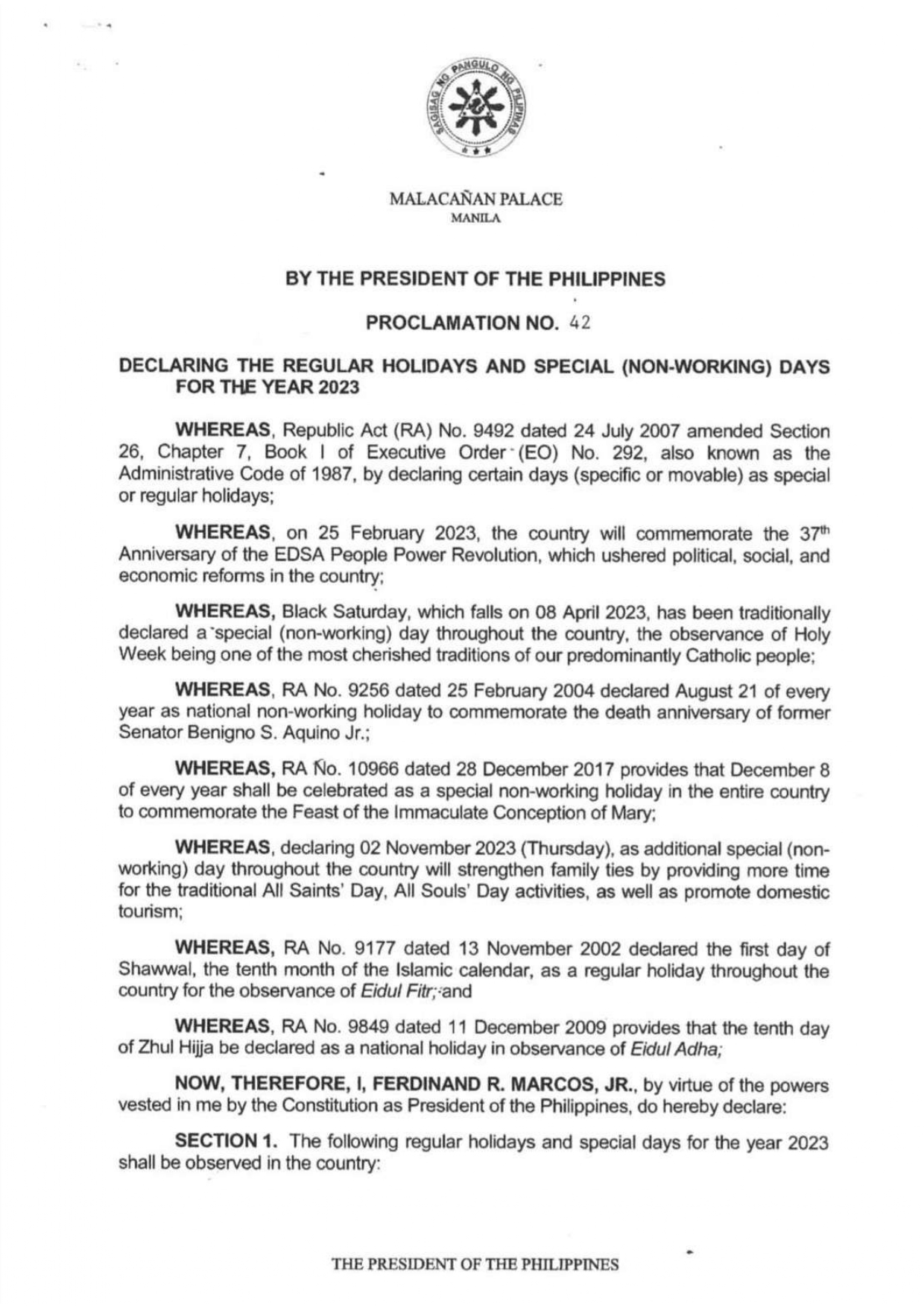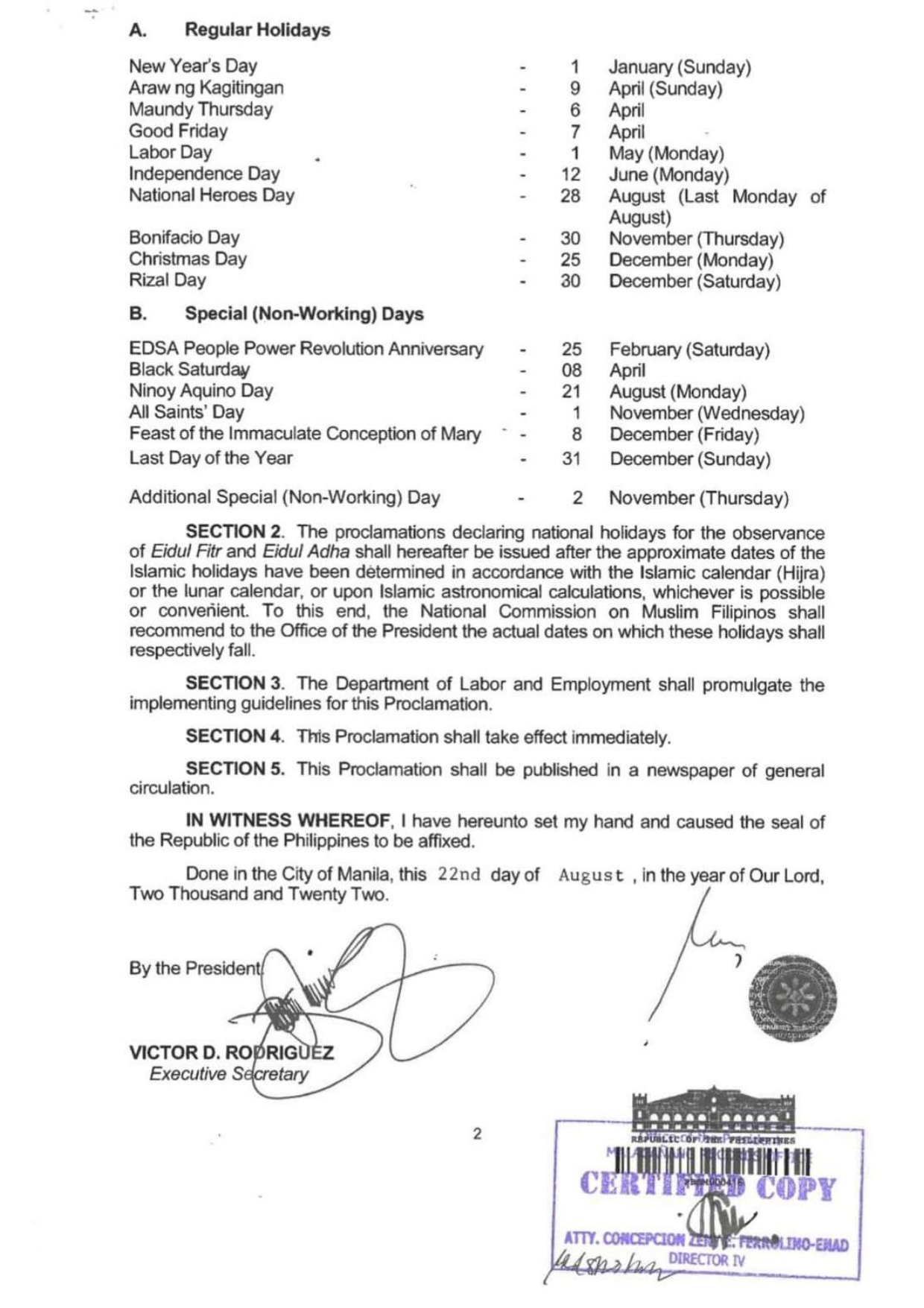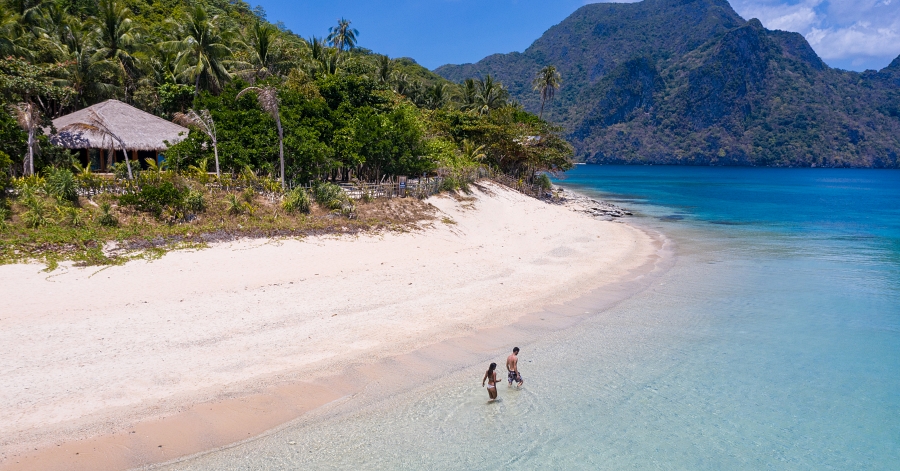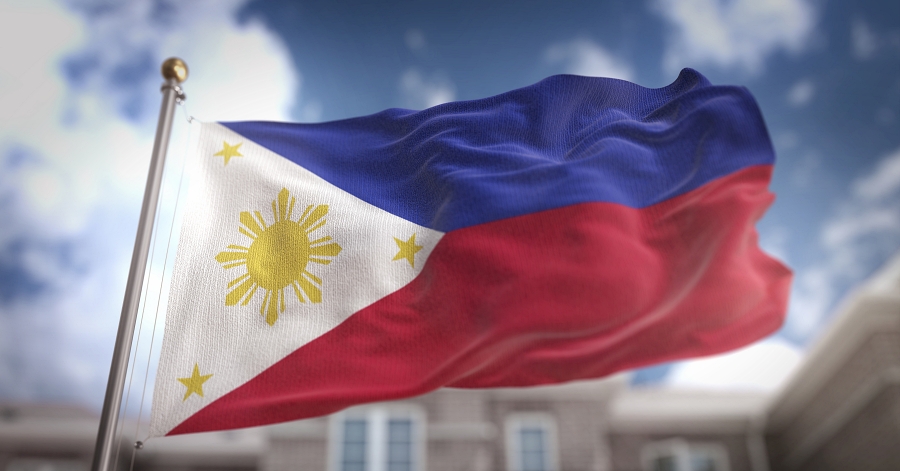As the curtain close draws nearer for 2022, which for some people would be a time to reflect and look forward, we can expect a lot of new things, including the Philippine Public Holidays next year. Despite the pandemic still raging on, we can expect a lot of new things in the next year. As of now, there have already been a lot of changes adopted by the government when it comes to travel, health, and safety protocols. This could just be an early indication of what’s to come in 2023.
ALSO READ: 10 Life-Changing Tips for OFWs to Better Manage Expenses During the Holidays
As we’re getting closer to the new year, listed below are some of the public holidays that Filipinos we’ll be enjoying this coming year. So mark your calendars, and get ready to plan for that revenge holiday trip around the country or even overseas! But before you get started, make sure to check out our list of the official public holidays in 2023:
Philippine Public and Special (Non-Working/Working) Holidays in 2023
Worth mentioning here was the announcement made by the government through Proclamation No. 1007, reducing the number of non-working holidays from 19 to merely 16.
As you may be aware, there are two types of holidays in the Philippines. Government organizations and enterprises in the private sector suspend work on a paid basis during regular holidays. Double compensation must be applied if a corporation decides to continue with work activities.
On the other hand, on non-working holidays, the government normally releases a portion that employers must pay to employees who will be reporting to work on the said dates.
Here is the official list of holidays in the Philippines for 2023:
Regular Holidays:
January 1 – Sunday – New Year’s Day
On December 31, Filipinos are expected to ring in the New Year with festivities. This event is also known as New Year’s Eve or New Year’s Day.
This time of the year, many Filipino families get together to celebrate and strengthen their ties.
April 9 – Sunday – Araw ng Kagitingan
On April 9, 1942, Major General Edward King led over 76,000 American and Chinese soldiers to surrender during the Japanese occupation of the Philippines.
During the Bataan Death March, thousands of prisoners died due to starvation and dehydration. They were forced to hike for 90 miles to a camp.
Despite the trials of defeat, the soldiers who survived the battle stood strong and were able to contribute to the victory.
The day of valor was declared a public holiday in 1980. It was also proclaimed as Araw ng Kagitingan in 1987.
April 6 – Maundy Thursday
During the Spanish rule, Holy Week was integrated into the Filipino culture. It became an important religious holiday in the country.
Maundy Thursday was declared an official holiday under the Republic Act (RA) 9492 of 2006.
April 7 – Good Friday
During Good Friday, most Catholics in the Philippines refrain from worldly activities such as drinking alcohol and listening to loud music. This is also the time when they refrain from eating meat.
In the Philippines, many people attend church services and participate in the acts of penance that are carried out by Jesus Christ. They do so by re-enacting the Stations of the Cross.
Mass is also held before 3pm in the church to commemorate the time when Jesus Christ died on the cross. On Good Friday, people also observe a moment of silence and solemnity.
During Good Friday, Filipinos are known to perform penance for their sins. This holiday is also a time when many people spend time at the beach.
May 1 – Monday – Labor Day
On May 1, Filipinos celebrate Labor Day. This day is used by workers to start rallies and demonstrations in order to demand their rights and demands.
On May 1, 1903, more than a hundred thousand labor activists led by the UODF marched from Plaza Moriones in Manila to Malacanang to demand for better working conditions.
June 12 – Monday – Araw ng Kalayaan
On June 12, 1964, the Philippines’ Independence Day was observed. This event was made possible through a law signed by the country’s former President Ferdinand Marcos.
This Act established the holiday known as Independence Day, which was based on the Philippine Declaration of Independence.
In 1898, the Philippines raised its flag and its national anthem. However, due to the lack of recognition by the US, the declaration was short-lived.
The Treaty of Paris ended the Spanish-American war. Spain surrendered its entire archipelago to the US.
The Philippines started a rebellion against the US in 1899, and it gained national sovereignty on July 4th, 1946, through the Treaty Of Manila.
Independence Day was declared on July 4 in 1964. This holiday was then moved to June 12 under a law passed in 1964.
On the day of Independence, many people join in the various parade held in the country. The highlight of the event is the military and police parade held in Manila, which is conducted by the country’s president.
August 28 (last Monday of August) – National Heroes Day
On National Heroes Day, Filipinos honor and remember their country’s heroes. This public holiday is held on the third Monday of November each year.
These individuals, who have made significant contributions to the Philippine’s development, are referred to as National Heroes. They are recognized for their courage and contributions to the country.
Following certain criteria, they came across a group of people who, they thought, should be honoured for their actions. These heroes include the likes of:
- Andres Bonifacio
- Apolinario Mabini
- Emilio Aguinaldo
- Gabriela Silang
- Jose Rizal
- Juan Luna
- Marcelo H. del Pilar
- Melchora Aquino
- Sultan Dipatuan Kudarat
November 30 – Thursday – Bonifacio Day
On November 30, 1863, Andres Bonifacio was born in the Philippines. He is regarded as the Father of the Resistance Movement against Spanish Colonialism.
On this day, Filipinos commemorate Andrés Bonifacio, the country’s national hero. He was the founder and leader of the secret society the Katipunan.
In 1921, the Philippine Legislature declared November 30 as a national holiday to commemorate the birth of revolutionary leader Gat Andrés Bonifacio.
December 25 – Monday – Christmas Day
any households decorate their homes and offices for Christmas. On other days, workers hold parties to celebrate the holiday. They also exchange gifts and sing carols.
During this time, children are given presents by their families and friends. They also receive Christmas cards before the holiday season begins.
For some, Christmas is a time for celebrating with family and friends, while for others it is a time for celebrating with strangers.
Christians believe that Jesus Christ was born on Christmas. However, it is not clear when the exact date was.
Scholars believe that Jesus was born on December 25, and that he was born on January 7.
The term “Christmas” originated from the old English term “Cristes maesse,” which means the mass of Christ. It is believed that the date was chosen to coincide with the festivities of the Pagan festivals of Saturnalia and Natalis Invicti.
It could also be that the holiday was established to coincide with the December solstice, which is when the northern hemisphere begins to grow longer. Various cultures hold varying beliefs about the birth of the light.
December 30 – Saturday – Rizal Day
On December 30, the nation honors Dr. Jose Rizal on his death anniversary. This event is widely celebrated in various places such as the Rizal Shrine in Calamba, Rizal Monument in Baguio City, and the Luneta Park in Manila.
On December 30, Rizal Day is declared a national holiday. It falls on a Sunday this year. This year’s theme is entitled “Rizalismo: Sandigan ng Kalawaran, Pagkakaisa at Kapyapaan.”
We often come up with a theme that will appeal to the nation’s nationalistic sentiments. The celebration of Rizal’s martyrdom is also a way to unite Filipinos.
It goes back to the order of General Emilio Aguinaldo, who declared December 30, 1898, as a day of mourning for Jose Rizal.
He ordered the flags of the country to be flown at half-mast on December 29 and all government offices to be closed on December 30 in a sign of mourning.
On December 30, 1898, the first Rizal Day celebration in the Philippines took place in Manila. The event was organized by the Filipino Club.
The Rizal monument was the first structure in the country to honor the revolutionary leader.
Special (Non-Working) Day
February 25 – Saturday – EDSA People Power Revolution Anniversary
The People Power Movement traces back to February 22 to 25, 1986, when masses of disillusioned individuals staged a revolution in Manila. The movement led to the downfall of the government.
EDSA in Manila was the main road used by millions of people during the revolution. During this period, it was also used as a protest site.
Many Filipinos consider the holiday important because of the revolution that brought about the political system reforms in the country.
People Power Day was a working holiday that occurred on February 25, 1992. This occasion was also a day when various activities and ceremonies were held to celebrate the anniversary.
In 2009, the Monday nearest February 25 was a special holiday for all schools.
People Power Day is celebrated by wearing yellow, which was their official color when they challenged the government in 1986.
Epifanio Delos Santos Avenue in Manila is a major road that has various festivities and events. Most of these are held during church masses and other special occasions.
People also flash the LABAN sign (“L” sign) to show their support for the revolutionary movement. The media outlets that broadcast the event also present programs about the day.
April 8 – Black Saturday
Black Saturday may also refer to: Holy Saturday, which is the day between Easter and Good Friday. On this day, most people go on holidays. The Battle of Pinkie Cleugh also took place place on this day.
In the Philippines, both the secular and religious authorities refer to the day after Good Friday as “Black Saturday.”
This day is devoted to remembering Jesus who was buried until his resurrection on Easter Sunday.
On Black Saturday, people come together to mourn the death of Jesus Christ. It’s also a day when preparations are made for the Easter Vigil, which is when the Blessed Sacrament is offered.
August 21 – Monday – Ninoy Aquino Day
On August 21, every year, the day is declared as Ninoy Aquino Day to commemorate the death of former Senator Benigno Aquino Jr.
Ninoy Aquino was a prominent politician and journalist who served as the mayor of Tarlac.
He was a member of the 7th Congressional District and was a rival of Ferdinand Marcos, who was the president at that time. He was among the first individuals arrested following the abolition of Congress.
He was charged with various offenses, including murder. During his military trial, he was imprisoned for over seven years. He was eventually released in the US for his health condition.
On August 21, 1983, Ninoy Aquino returned to the US after being exiled for three years. He traveled with the media by his side.
Ninoy Aquino was shot and killed by a passenger while he was walking toward the plane’s exit. His death marked the beginning of the People Power Revolution.
He was survived by his wife Corazon C. Aquino, who was the first woman president of the Philippines; his children, who were all very young when he died; and his son, who was the 14th Congress president.
November 1 – Wednesday – All Saints Day
All Saints’ Day is a day that recognizes the saints of the Christian faith. It is also celebrated on Sundays in many churches.
All Hallows Day is celebrated on November 1. It is also known as All-Hallomas or All-Day.
In some countries, such as Spain and Portugal, All Saints’ Day is celebrated with religious offerings.
In some countries, such as Italy and Belgium, people bring flowers to the graves of their dead relatives. In other regions, such as Austria and Croatia, people light candles on top of the graves of their dead relatives.
In some parts of Asia, people visit the graves of their deceased relatives to clean them. They also light candles and visit the graves to honor their relatives.
On November 1, France’s churches hold services in memory of saints. The evening is devoted to the dead.
On November 2, All Saints’ Day is closely linked with All Souls’ Day, which is dedicated to the prayers of the dead.
The idea of All Saints’ Day dates back to the 4th century. It’s when the Greek Christians paid tribute to all saints and martyrs.
Other sources suggest that the holiday was established around 270 CE. It was made an authorized holiday by Pope Gregory IV in 835 CE.
It is believed that the event was chosen to replace the Festival of the Dead, which was held on November 1.
All Saints’ Day is not the same as All Souls’ Day. It was first established in a Benedictine monastery in Central Europe in the 9th century.
December 8 – Friday – Feast of the Immaculate Conception of Mary
On December 8, Christians around the world celebrate the feast of the Immaculate Conception. This day is a day of obligation that many Catholics attend.
On this day, Christians around the world commemorate the feast of the Immaculate Conception.
The feast of the Immaculate Conception is celebrated on December 8. In some places, it is a public holiday.
The feast of the Immaculate Conception, which is also known as the Day of the Immaculate Conception, was surrounded by controversy for centuries.
The word “immaculate” refers to the belief that Jesus’ mother Mary was not conceived with original sin.
During the early years of Christian history, theologians such as St. Thomas Aquinas, criticized the Immaculate Conception.
The Ineffabilis Deus is a written document that explains the belief that Mary was conceived without sin.
December 31 – Sunday – Last Day of the Year
New Year’s Eve is the last day of the year that coincides with the Gregorian calendar. So, whether you’re in the US or in the Philippines, count down to the New Year.
On the other hand, it’s a time to reflect on the year gone by and prepare for the new year.
Some people have a sense of nostalgia as they look back at the past year. This is when they reflect on the events that happened in their lives during that period.
While some people attend midnight church services, others gather in public areas such as Times Square in Manhattan or London’s Trafalgar Square to count down the new year.
Many people have small gatherings at home. These festivities are highlighted by fireworks displays.
As the clock strikes midnight on New Year’s Eve, many people wish each other a “Happy New Year”.
In some parts of the world, people sing the Scottish song “Auld Lang Syne” during New Year’s Eve festivities.
On New Year’s Eve, which is the last day of the current year, it marks the beginning of a new year and the end of the old year.
In 1582, Pope Gregory XIII officially introduced the Gregorian calendar. It was adopted in various countries later in the 17th and 18th centuries.
The origins of New Year’s Eve can be traced back to festivals that were held in Europe before Christianity was widely practiced. When people were converted to Christianity, they merged these festivals with their Christian beliefs.
Although many cultures follow the same Gregorian calendar, some observe different dates for the New Year. For instance, some observe the Islamic calendar while the Chinese and Jewish calendars have different dates.
On Special Working Holidays
Meanwhile, special working days have been designated on November 2 (All Souls’ Day), December 24 (Christmas Eve), and December 31 (New Year’s Eve).
The proclamations that are made regarding the observance of the Islamic holidays of Eid’l Adha and Eid’l Fitr will be issued after the dates of the holiday have been determined. These can be determined by the Islamic calendar or by Islamic astronomical calculations.
During Eid al-Fitr, Muslims around the world mark the end of the month of fasting known as Ramadan.
During Eid al-Fitr, Muslims attend communal prayers and listen to a khutba while giving zakat al-fitr in the form of food.
On the first day of Shawwal, many Muslims attend a khutba or sermon. They pray outside or in large venues.
On this day, some communities organize various festivities, such as food and fun for children.
If a Muslim has not given Zakat al-fitr during the month of Ramadan, he or she can do so on Eid-al- Fitr.
Many Muslims may also prepare and eat food to celebrate Eid al-Adha. They also visit their relatives and friends.
You can also send cards that feature the greeting: Eid Mubbarak.
Similarly, Eid al Adha, is an Islamic festival that recalls the willingness of Ibrahim to sacrifice his son for God.
On Eid al-Adha, Muslims make a special effort to listen to a sermon or pray at a mosque.
They also wear new clothes and visit their relatives and friends. In an act known as qurbani, they symbolically sacrifice an animal.
In some countries, Muslims may buy an animal known as udhiya to sacrifice. This is not common in other countries, such as the U.S. and United Kingdom.
During the Eid al-Adha period, many Muslims go to Mecca and the surrounding area to perform the pilgrimage.
Package holidays are arranged for Muslims from various countries. They can plan and save for many years so they can take part in this event.
In Judaism and Christianity, God told Ibrahim to sacrifice his son, Ishmael. He took his son to Mount Moriah.
Just as he was about to sacrifice his son, an Angel appeared and gave him a ram to carry in place of his son.
The Islamic calendar is based on the observations of the Moon. In most cases, its length can vary between years. For instance, the dates of Eid al-Adha may be changed at the start of a month.
Here is the announcement post as shared by the Philippine government about the list of holidays in 2023 in the Philippines:


FINAL THOUGHTS

With the official list of Philippine holidays for 2023 now available, you can start planning your vacations and long weekends. If you are working outside the Philippines and planning to visit your family back home, it might be a good idea to go during these holidays.
We hope that this list of holidays will help you plan your year. If you need more information about the Philippine holidays, you can visit the official website of the Department of Labor and Employment (DOLE).
ALSO READ: Palawan Hailed as One of the Best Islands in the World – Survey
